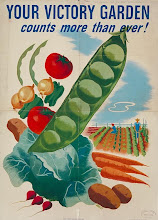I spent about half-an-hour in the garden after getting home from work yesterday. Pulled all of the onions out (I didn't plant that many--why plant onions when your whole family hates them?), two garlic bulbs that we apparently missed during the earlier harvest, a big bowl of green beans, four ripe tomatoes (our first ripe tomatoes!), and one chioggia beet.

Ask me if I planted chioggia beets this year. Go on, ask me. [Go on, go on, go on. Father Ted -- funniest TV show ever.]
No! I didn't plant chioggia beets this year. I planted them LAST year. But there, in the middle of my (now) onion/garlic patch, was a beet. Last year that area was the beet patch. Supposed-to-be beet patch, anyway. No beets actually grew. I attributed it to either bad seed or a too-early planting. After Memorial Day rolled around and I realized I wasn't going to get any beets, I planted a few tomatoes in there instead.
How did this one beet seed survive the winter? Granted, I did put down straw to protect the garlic, so it did have a few inches of mulch. But why didn't it grow last summer? I just don't get it. Oh well.

I stayed up way too late last night canning green beans. I stayed up way too late the night before freezing cauliflower soup. Tonight I'll probably stay up way too late making pickle relish. These are called the dog days of summer because you work like a dog trying to get everything harvested and preserved before it's too late.

On Thursday afternoon I had an awesome opportunity to take a tour of our neighboring Hutterite Colony. It was a half-hour tour that ended up being two hours long. We walked through their gardens (thirteen acres of garden!), their garden shop, their preservation kitchens, their freezers and cold storage areas, their pantries and dining areas, and their workshops. It was absolutely amazing. I am still reeling from it.
They were so friendly, and answered the most stupid of questions. They make so many things from scratch, and they plan out their entire year's worth of food needs ahead of time. They know how many pickled beets and canned beets and baked beets they eat each year, and that dictates how many beets get planted in the garden each spring. They have about eighty people in their colony -- can you imagine the level of food planning needed for eighty people? Not only vegetables, but meats and grains and dairy and spices and everything else. Makes my tiny basement pantry look feeble, indeed.
Oh yeah, the picture above -- they even puff their own wheat. A very nice older man in the colony, who apparently can build/fix just about anything, built a home-made wheat puffer. By himself. He showed me how it works -- the wheat gets poured into a heavy-duty, thick-sided pressure tank, which is sealed and pressurized up to 200 psi. Then it is tipped over and opened into a large screened container beneath. The wheat puffs up when it makes contact with the air, releasing all that built-up pressure.
The man insisted I take some puffed wheat home with me. It's really good mixed with honey. We are set for breakfast cereal for the next few weeks.

And lastly, here is our kitty. She is very sweet. Still very playful, but loving as well. She likes to lick ears and noses. She likes to bite toes. She loves tunnels. Build a tunnel out of cushions, shoes, books, whatever, and she will go right in. The boys love her.
It's raining right now. It's been raining all day, and will probably keep raining 'til this evening. A good excuse to stay inside and catch up on some cleaning. Or reading. Or playing. Or napping.












































